Multi-planet Mode¶
Estimate the intrinsic distribution of planetary systems by fitting a population of multi-planet systems to Kepler data
[1]:
import EPOS
import numpy as np
import matplotlib.pyplot as plt
initialize the EPOS class
[2]:
epos= EPOS.epos(name='example_2')
|~| epos 3.0.0.dev2 |~|
Using random seed 493439428
Read in the kepler dr25 exoplanets and survey efficiency packaged with EPOS
[3]:
obs, survey= EPOS.kepler.dr25(Huber=True, Vetting=True, score=0.9)
epos.set_observation(**obs)
epos.set_survey(**survey)
Loading planets from temp/q1_q17_dr25_koi.npz
6853/7995 dwarfs
3525 candidates, 3328 false positives
3040+1 with score > 0.90
Observations:
159238 stars
3041 planets
1840 singles, 487 multis
- single: 1840
- double: 324
- triple: 113
- quad: 38
- quint: 10
- sext: 2
Define the function that describes the intrinsic planetary system population. Here we use a double broken power-law from EPOS.fitfunctions to deinfe the location and size of the innermost planet in each system.
[4]:
epos.set_parametric(EPOS.fitfunctions.brokenpowerlaw2D)
brokenpowerlaw2D takes 8 parameters. The two dependent parameters are the period and radius. There are 6 free parameters (xp, p1, p2, yp, p3, p4) and a normalization parameter. Let’s define them:
The normalization parameter, labeled pps, defines the fraction of stars with planetary systems. Let’s assign a planetary system to 40% of stars, and exclude negative numbers with the min keyword.
[5]:
epos.fitpars.add('pps', 0.4, min=0, isnorm=True)
Initialize the 6 parameters that define the distribution of the innermost planets, fixing the radius distribution.
[6]:
epos.fitpars.add('P break', 10., min=2, max=50, is2D=True)
epos.fitpars.add('a_P', 1.5, min=0, is2D=True)
epos.fitpars.add('b_P', -1, max=1, dx=0.1, is2D=True)
epos.fitpars.add('R break', 3.3, fixed=True, is2D=True)
epos.fitpars.add('a_R', -0.5, fixed=True, is2D=True)
epos.fitpars.add('b_R', -6., fixed=True, is2D=True)
define the simulated range (trim) and the range compared to observations (zoom)
[7]:
epos.set_ranges(xtrim=[0,730],ytrim=[0.3,20.],xzoom=[2,400],yzoom=[1,6], Occ=True)
Show the inner planet distribution
[8]:
EPOS.plot.parametric.panels(epos, NB=True)
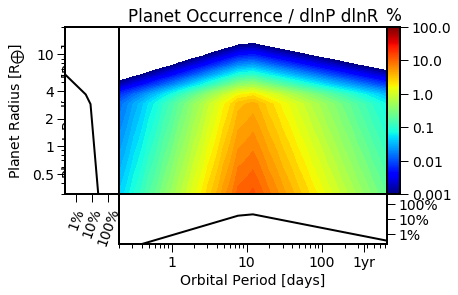
Define the locations of additional planets in the system. Here, let’s use 10 planets per system, with the spacing drawn from a dimensionless distribution
[9]:
epos.set_multi(spacing='dimensionless')
epos.fitpars.add('npl', 10, fixed=True) # planets per system
epos.fitpars.add('log D', -0.3)
epos.fitpars.add('sigma', 0.2, min=0)
EPOS.plot.multi.periodratio(epos, Input=True, MC=False, NB=True)
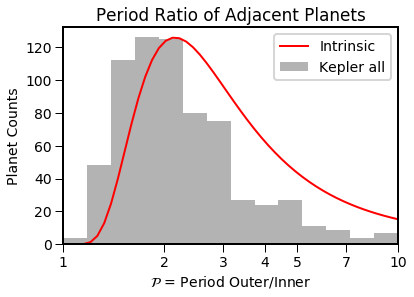
Define the mutual inclinations, drawn from Rayleigh distribution with mode 2 degrees
[10]:
epos.fitpars.add('inc', 2.0) # mode of mutual inclinations
Fraction of system with high mutual inclunations to fit the Kepler dichotomy
[11]:
epos.fitpars.add('f_iso', 0.4) # Fraction of isotropic systems
Add a dispersion to the radii of planets in each system
[12]:
epos.fitpars.add('dR', 0.01, fixed=True)
Generate an observable planet population with the inital guess and compare it to Kepler
[13]:
EPOS.run.once(epos)
Preparing EPOS run...
6 fit parameters
Set f_cor to default 0.5
Starting the first MC run
63695/356370 systems
Average mutual inc=2.4 degrees
356370 planets, 9647 transit their star
- single: 4632
- double: 1082
- triple: 456
- quad: 217
- quint: 81
- sext: 24
- sept: 6
- oct: 3
9647 transiting planets, 2145 detectable
- single: 1263
- double: 226
- triple: 87
- quad: 29
- quint: 7
- sext: 3
Goodness-of-fit
logp= -160.4
- p(n=1548)=1.9e-58
- p(x)=3.5e-08
- p(N_k)=0.84
- p(P ratio)=0.027
- p(P inner)=0.0014
observation comparison in 0.044 sec
Finished one MC in 0.475 sec
Show the simulated detections
[14]:
EPOS.plot.periodradius.panels(epos, NB=True)
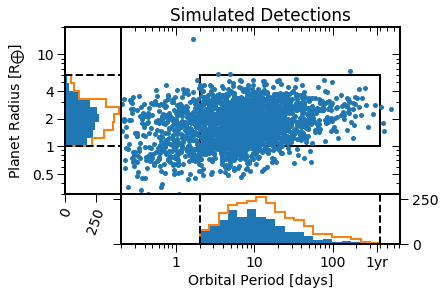
And the detectable planet architectures, compared to the initial distributions
[15]:
EPOS.plot.multi.multiplicity(epos, MC=True, NB=True)
EPOS.plot.multi.periodratio(epos, Input=True, MC=True, NB=True)
EPOS.plot.multi.periodinner(epos, MC=True, NB=True)
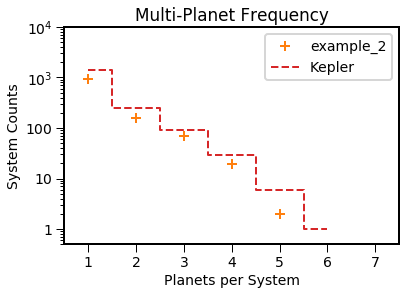
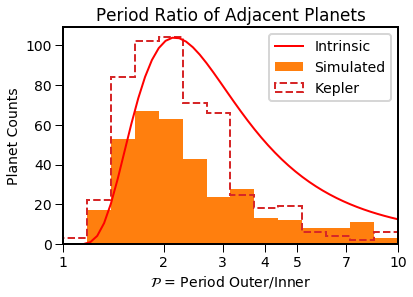
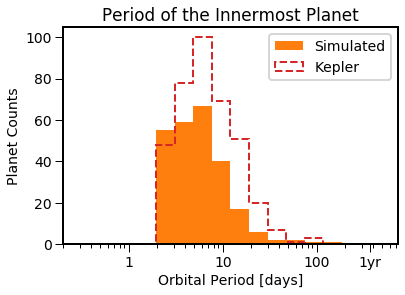
The simulated distributions are a bit different from what is observed. Let’s minimize the distance between the distributions using emcee. (Note the counter doesn’t work yet)
[16]:
EPOS.run.mcmc(epos, nMC=100, nwalkers=20, nburn=20, threads= 8, Saved=True) # ~20 mins
#EPOS.run.mcmc(epos, nMC=500, nwalkers=50, nburn=200, threads= 8, Saved=True) # ~20 mins
#EPOS.run.mcmc(epos, nMC=1000, nwalkers=100, nburn=200, threads=20, Saved=True) # ~5 hrs
Loading saved status from chain/example_2/20x100x8.npz
NOTE: Random seed changed: 3119675631 to 493439428
MC-ing the 30 samples to plot
Mercury analogues < 3.3% +1.2% -1.1%
1 sigma UL 3.9%
2 sigma UL 5.1%
3 sigma UL 12.2%
Venus analogues < 0.9% +0.4% -0.3%
1 sigma UL 1.2%
2 sigma UL 1.6%
3 sigma UL 4.9%
Best-fit values
pps= 0.57 +0.0583 -0.0365
P break= 10.8 +1.87 -1.39
a_P= 1.61 +0.246 -0.191
b_P= -1.3 +0.171 -0.107
log D= -0.345 +0.0311 -0.0343
sigma= 0.187 +0.0225 -0.019
inc= 1.92 +0.684 -0.67
f_iso= 0.418 +0.0635 -0.0459
Starting the best-fit MC run
90776/565953 systems
Average mutual inc=2.3 degrees
565953 planets, 14997 transit their star
- single: 6926
- double: 1572
- triple: 783
- quad: 353
- quint: 133
- sext: 52
- sept: 20
- oct: 5
- nint: 1
14997 transiting planets, 3087 detectable
- single: 1743
- double: 354
- triple: 135
- quad: 34
- quint: 14
- sext: 3
- sept: 1
Goodness-of-fit
logp= -13.7
- p(n=2277)=0.47
- p(x)=0.0014
- p(N_k)=0.94
- p(P ratio)=0.11
- p(P inner)=0.016
Akaike/Bayesian Information Criterion
- k=8, n=2336
- BIC= 89.4
- AIC= 43.4, AICc= 2.7
observation comparison in 0.083 sec
Let’s look at the posterior distributions
[17]:
EPOS.plot.periodradius.panels(epos, MCMC=True, NB=True)
EPOS.plot.multi.multiplicity(epos, MCMC=True, MC=True, NB=True)
EPOS.plot.multi.periodratio(epos, MCMC=True, MC=True, NB=True)
EPOS.plot.multi.periodinner(epos, MCMC=True, MC=True, NB=True)

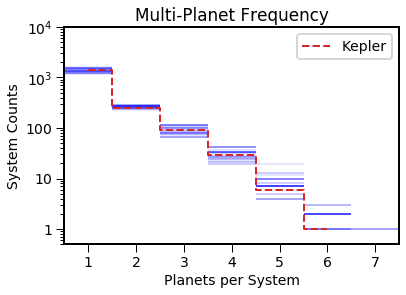
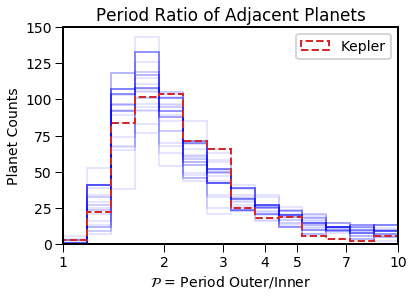
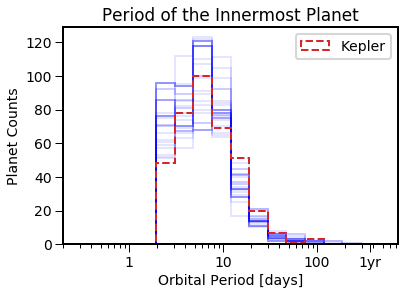
Save the planet populations to a csv file
[18]:
popdict= dict(all_systems=epos.population,
transiting_systems= epos.population['system'],
transiting_planets= epos.synthetic_survey)
for key, pop in popdict.items():
fname= 'csv/'+epos.name+'_'+key
EPOS.save.to_csv(fname, starID= pop['ID'], Period_days= pop['P'], Radius_earth= pop['Y'])
[ ]: